Road Safety and Traffic Management
The City of Whitehorse strives to develop, operate, and maintain an accessible, equitable, safe, and sustainable transportation network for all modes of transportation, ages, abilities, and seasons.
Road safety and traffic management is managed by many levels of government and governments cooperate to advance areas of mutual interest.
The City of Whitehorse is responsible for road safety and traffic management as it specifically relates to the City’s policies, programs, and infrastructure under its jurisdiction. Where the City has limited authority and jurisdiction, the City regularly collaborates with partnering organizations and government agencies (e.g. Government of Yukon, Yukon RCMP) to deliver initiatives and projects of mutual interest and influence.
The City of Whitehorse is responsible for the following:
- Design, operations and maintenance of the transportation network.
- Development of City-specific transportation policies and bylaws.
- Road safety, traffic management, temporary street use, and traffic operations.
- Enforcement of parking violations.
The Yukon RCMP is responsible for traffic enforcement within the City.
The Government of Yukon’s Department of Highways and Public Works is responsible for territorial transportation legislation and regulation, vehicle licensing, road safety education, and road user education. They are also responsible for the Alaska Highway Corridor through Whitehorse.
Crosswalks
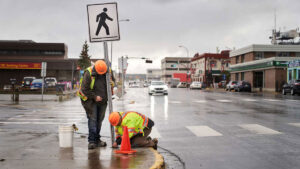
(Marked) crosswalks are a traffic control device used to alert drivers to areas with high pedestrian crossing activity and facilitate safer passage of pedestrians crossing the street. Not every location with pedestrian crossing activity is a candidate location for a marked crosswalk as many factors need to be considered including but not limited to driver expectancy, proximity of marked crosswalks, and local context.
There are three types of (marked) crosswalk systems:
- Passive crossing treatment system: consists only of signs and pavement markings.
- Active crossing treatment system: consists of signs, pavement markings, and pedestrian-activated warning devices such as flashing beacons.
- Traffic signal system: consists of signage, pavement markings, and pedestrian-activated traffic signals.
(Marked) crosswalks are typically installed in locations with:
- Insufficient gaps in traffic for safe pedestrian crossing.
- High pedestrian crossing volumes.
- High concentration of vulnerable road users (e.g., children, seniors, people with disabilities) and/or historically marginalized peoples (e.g., low-income persons)
Crossrides
![]()
Crossrides (City of North Vancouver, 2023)
A crossride (also called elephant’s feet markings) are dots that are parallel to crosswalk markings that tell cyclists they do not need to dismount when crossing an intersection. Crossrides are mostly found at areas where bicycles use City streets such as multi-use pathway and bicycle lane intersection crossings.
Pedestrians should watch for crossrides so they do not accidentally walk in a crossride area. Cyclists should always yield to pedestrians, slow down and only cross when it’s safe. Motorists should watch for crossrides, slow down and yield to anyone using the crossing.
Marked crossrides are typically installed in locations with:
- High cycling crossing volumes.
- Multi-use pathways intersection crossings.
- Bike lane intersection crossings.
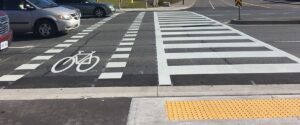
Separated crossride (left) and crosswalk (right) at a signalized intersection (City of Sudbury, 2023)
The City of Whitehorse, in collaboration with partner organizations and government agencies, have several ongoing road safety programs to raise awareness and improve road safety throughout the city.
Speed Radar Trailer Program
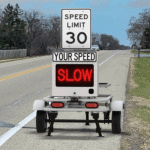
Speed radar trailer (Adaptive Displays, 2023)
The City has a speed radar trailer that can be placed on local, minor, and major streets to alert drivers about the speed limit and help reduce speeding.
Speed Radar Trailer Schedule
| Date | Location | From | To |
|---|---|---|---|
|
First two weeks after Christmas Break |
School Zones | N/A | N/A |
| First two weeks after Spring Break | School Zones | N/A | N/A |
| First two weeks after Summer Break | School Zones | N/A | N/A |
Neighbourhood Street Sign and Pace Car Program
The Neighbourhood Street Sign and Pace Car Program is how Whitehorse residents can show other drivers they’re taking a stand against speeding. Each toolkit comes with:
- a lawn sign you can place in your front yard to remind drivers to slow down and drive safely; and
- a window decal for your vehicle.
Be the change on our roads and follow all the road rules and speeds. Let’s drive right every trip and show them how it’s done.
This campaign is a partnership between the City of Whitehorse, the RCMP and the Government of Yukon.
Click here to learn more about this initiative.
School Zone Road Safety Campaign 2022-2023
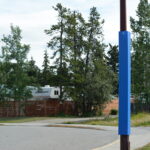
The School Zone Road Safety Campaign 2022-2023 is a collaboration between ATCO Electric Yukon, the Government of Yukon, and Yukon RCMP with the goal of raising awareness about road safety in school zones. The goal is to enhance school traffic safety by providing additional visual indicators that let you know you’re driving in a school zone. This will be done by placing blue boxes around streetlights in designated school zones.
Click here to learn more about this initiative.
The City of Whitehorse installs and maintains signage and pavement markings on City streets to inform road users about rules of the road, regulations, potential hazards, temporary conditions, construction, and guidance and wayfinding.
Standards
The City of Whitehorse installs and maintains signage, pavement markings and other traffic control devices as per the TAC Manual of Uniform Traffic Control Devices for Canada (Transportation Association of Canada) standards, TAC guidance, and City of Whitehorse Engineering Standards.
All signage and pavement markings installed on City streets require approval by the City Engineer and the City Manager.
Pavement Markings Program
The Fleet and Transportation Maintenance Department reinstates pavement markings each year. Typically, longitudinal pavement markings are implemented earlier in the summer season (May) and transverse and other pavement markings (crosswalks) are implemented afterwards and throughout the summer season.
Painted Curbs and Medians
The City does not paint curbs and medians to indicate traffic regulations (e.g. parking regulations) except in the following locations/circumstances:
- The nose of medians to aid drivers and maintenance operators in identifying raised directional divisions in traffic.
- Crosswalks & crossrides with reported safety concerns validated by an engineering study.
- Locations where installing signage is practically unfeasible or would cause adverse impacts to other road users (e.g. clear width available for people with mobility devices).
- Locations where the traffic bylaw and signage cannot adequately communicate traffic regulations.
Speed limits for all streets in the City are shown in the Traffic Bylaw.
The City periodically reviews speed limits across the City to improve safety and ensure that speed limits match the surrounding context. Speed limits on City streets are determined by the City by considering an array of factors such as:
- Standards and guidance
- Street classification (local, collector, arterial)
- Adjacent land use (e.g. urban, rural)
- Level of activity and conflict
- Concentration of vulnerable road users
- Local context
Changes to speed limits require revisions to the Traffic Bylaw. As such, the City is not considering localized changes to speed limits at this time.
School Zones
The City implements school zones to reduce driver speeds and improve safety for vulnerable road users such as children at or near schools. Motorists should always watch for children and be aware of children near schools.
At schools that have school zone signage, the speed limit is 30 km/hr. The playground zone starts at the “start of the school zone” sign and ends either at 1) the “end of school zone” sign, 2) back of the school zone sign in the opposite direction, 3) or at the reinstatement of the prior speed limit.
Playground Zones
The City implements playground zones to reduce driver speeds and improve safety for vulnerable road users such as children at or near playgrounds. Motorists should always watch for children and be aware of children near playgrounds.
At playgrounds that have playground zone signage, the speed limit is 30 km/hr. The playground zone starts at the “start of the playground zone” sign and ends either at 1) the “end of playground zone” sign, 2) back of the playground zone sign in the opposite direction, 3) or at the reinstatement of the prior speed limit.
Apply for a Street Occupancy Permit
The City manages street use and street occupancy for things like construction, partial or full street closures, parades, festivals, and protests. A street occupancy permit requires approval by the City Engineer.
Click here to learn more about Street Occupancy Permits.
Street Occupancy Permit Application
Construction
The City of Whitehorse has a short and intense construction season with much of our essential construction work happening during our summer construction months. The City and contractors strive to manage safety and traffic to protect all road users, construction workers, the general public, and minimize overall traffic disruptions.
Contractors wishing to use the street for construction purposes require a Street Occupancy Permit. A Street Occupancy Permit requires approval by the City Engineer.
Click here to learn more about our ongoing construction projects, upcoming road work and street closures.
Oversize/Overweight Vehicles
Carriers shipping oversize and overweight vehicles through the City of Whitehorse require a Street Occupancy Permit. A street occupancy permit requires approval by the City Engineer.
Parades, Festivals, and Protests
Parades, festivals, and/or protests on City streets require a Street Occupancy Permit. A street occupancy permit requires approval by the City Engineer.
The Yukon RCMP is responsible for traffic enforcement. Click here for more information about the Yukon RCMP.
The City does not conduct enforcement of moving traffic (e.g., speeding, red light running)
Evaluation and Monitoring
The City of Whitehorse regularly monitors and evaluates key performance indicators for the transportation network including but not limited to level of service (LOS), road safety, traffic volumes, and traffic speeds.
Traffic Data Collection
There are limited private traffic data collection services available in Whitehorse and throughout the Yukon. As such, select traffic data may be obtained through the City of Whitehorse or other third-party data providers. The City has equipment to collect screenline and turning movement counts using automated data collection devices.
The City can provide data collection services (labour, materials, set up) and provide raw, unadjusted data at cost upon request. In exchange for provision of new traffic data, the City obtains the data as per its requirements and retains ultimate ownership of the data.
Click here to request traffic data.
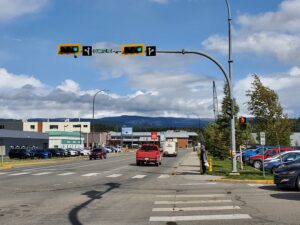
Traffic signals are a traffic control device used to manage the safe movement of road users including pedestrians, cyclists, transit users, and vehicles. Traffic signals may be installed for safety, operational, physical, strategic, and special considerations.
The City of Whitehorse installs, operates, and maintains traffic signals within the City, except those on the Alaska Highway through Whitehorse.
The Government of Yukon’s Department of Highways and Public Works installs, operates, and maintains traffic signals along the Alaska Highway through Whitehorse.
Upcoming Traffic Signal Changes
| Location | Date | Description of Changes |
|---|---|---|
| All traffic signals | February-March 2023 | Signal timing updates |
Eligibility and Criteria for Installation
The City periodically reviews intersections to identify the need for traffic signalization and improvements. Traffic signals may be warranted when any of the following conditions are met:
- History of collisions between road users.
- High pedestrian volumes across an intersection with insufficient gaps for safe pedestrian crossing movements.
- High through or left turn volumes from a minor approach at a major-minor intersection with insufficient gaps for safe vehicular movement.
Traffic Signal Operations
Traffic signals are programmed to facilitate the safe and efficient flow of traffic and minimize conflicts between all road users. The City periodically reviews traffic signal timing and programming for all signals to ensure that the traffic signals meet the ever-changing and dynamic needs of traffic.
Our traffic signals operate by assigning the right-of-way to different traffic movements. Each phase includes the green, amber and red time assigned to a specific traffic movement. The cycle length is the total time it takes to serve each phase. Increasing the cycle length improves the intersection capacity by providing longer continuous green time, but also increases the average delay for vehicles waiting at the intersection.
Types of Traffic Signal Operations
The City uses three types of signal operations:
- Fixed time: there are no pedestrian or vehicle detectors. The time given to each phase is preset and independent of vehicle volumes and demand.
- Semi-actuated: there are pedestrian and vehicle detectors along the minor street only. When there is low demand, the minor street phases are able to end early or be skipped entirely when no vehicles are present. Excess time is transferred to the major street phase. Pedestrians crossing the minor street will be served each cycle, while crossings of the major street will only be served by using the pedestrian pushbuttons.
- Fully-actuated: there are pedestrian and vehicle detectors for all directions of travel. Phases are served, extended, or end early depending on traffic demand. Pedestrians will only be served when the pushbuttons are used.
Traffic signal timing and programming is prepared by modelling existing and projected traffic demands and optimizing traffic flow using industry traffic modelling software. Traffic signal modelling and timing is usually conducted by a civil engineer with specialized expertise in traffic operations.
Timing Plans
Different timing plans are often used throughout the day to reflect changing traffic conditions. At most intersections, morning and afternoon plans accommodate both rush hour periods, while a non-peak plan for the remainder of the day. Traffic signals in Whitehorse are typically programmed for the following times:
- Weekday
- Morning traffic peak hour (07:00-09:00, Monday-Friday)
- Mid-day traffic peak hour (11:00-13:00, Monday-Friday)
- Afternoon traffic peak hour (15:00-18:00, Monday-Friday)
- Weekend
- Mid-day traffic peak hour (11:00-13:00, Saturday)
- All other times
Pedestrian Phasing
The pedestrian walk interval indicates that pedestrians at an intersection may cross the street. The pedestrian walk interval is usually indicated by a white human symbol on a pedestrian signal head.
The pedestrian clearance interval indicates that pedestrians at an intersection may not cross the street as the traffic signal will change to the opposing direction. The pedestrian clearance interval is usually indicated by a red flashing hand symbol on the pedestrian signal head. The pedestrian clearance interval is timed to allow pedestrians of all ages and abilities to safely finish crossing the intersection before the onset of conflicting traffic flow.
Vehicular phasing
The green interval indicates that a vehicle may proceed in the direction of travel flow. The amount of green time allocated to a particular phase depends on a variety of factors such as location, time of day, traffic signal operation, current traffic demand, and traffic analysis and modelling.
Emergency Vehicle Priority and Pre-Emption
Traffic signals in the City are equipped with acoustic pre-emption devices. Acoustic pre-emption devices are devices fixed on traffic signal arms to aid emergency response vehicles in responding to a call. When the device hears the sound of an emergency siren, the device will send a call to the traffic signal in the direction of an oncoming emergency vehicle.
Left Turn Phasing
Accommodating left turns in the transportation network can be difficult as it has the highest conflict potential. Installation of left turn phasing may be required in special cases to facilitate safe and efficient left turn traffic, however, often increases the overall cycle length and delay for all road users at an intersection.
No Right Turn on Red
Some signalized intersections in the City have no right turn on red to minimize conflicts between right turning vehicles and pedestrians and cyclists.
Turn Restrictions
Turn restrictions may be implemented at locations to improve the safety and efficiency of traffic.
Flashing Signals
Occasionally, traffic signals malfunction and/or experience power outages.
- If the traffic light is flashing red, treat it like a stop sign.
- If the traffic light is flashing yellow, treat it like a yield sign.
Power Outage
At older traffic signals in the City, lights may not be illuminated in a power outage. If no lights are illuminated, drivers should treat the intersection like a four-way stop.
Detection
Pedestrian and Bicycle Detection
At intersections requiring pedestrian detection, pedestrians are detected by pushbuttons installed on the traffic signal.
At intersections requiring bicycle detection, bicycles are detected by bicycle-friendly pushbuttons installed on a separate pole away from the main traffic signal pole.
Vehicle Detection
At intersections requiring vehicular detection, vehicles are typically detected by electromagnetic induction loops. Electromagnetic induction loops are located within in the pavement surface behind the stop bar on an intersection approach. When an electromagnetic induction loop detects a high concentration of metal, the loop sends a call to the traffic signal.
Smaller vehicles may not always be detected by a traffic signal due to the low volume and concentration of steel. This may include motorcycles, bicycles, e-bikes, etc.
Become a Traffic Operations Engineer
Have you ever wanted to try being a traffic engineer? Have you ever wanted to try solving traffic problems?
Click here to play the Gridlock Buster Traffic Control Game to learn about traffic signal timing and programming.
Learn More
Here are some resources on traffic signals:
